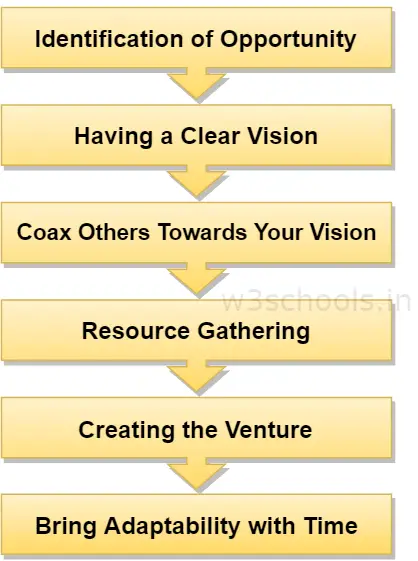Every subject and every method you have learned so far has some specific steps to follow or understand. From the very basics of any topic or its applied section to its advanced usage and requirements, all follow some specific stages. Entrepreneurship also follows some entrepreneurial development methodologies, and each of these terms has specific functionalities as well.
Process for Entrepreneurship
The Entrepreneurship Process can be expressed as a set of procedures and methodologies, followed by entrepreneurs to establish a new business or venture. All the entrepreneurship process phases have certain meanings and functionality, which one has to trail and pursue for setting up a venture.
Here is a flow diagram of the different phases of the Entrepreneurship process.

Let us discuss each of the phases in brief:
Identification of Opportunity
At the very early stage, an entrepreneur has to detect a problem in society and sense out some opportunities and visualize the market or consumer ratio. His/her creativity and innovation will also bring challenges. Entrepreneurs should look for the scope to find an alternate efficient solution for needs, wants, detecting issues and problems, and effective solutions. If you're opting for the solution and you as an entrepreneur is standing in the very front, then you are on the advantageous side, which provides product identification and top reliability in the market.
Having a Clear Vision
There is a say - "A vision without implementation is just a dream with closed eyes." Another phase that the entrepreneur must have to see while creating his empire is to look beyond the idea or plan. He/she has to have a vision from the experience and a creative mindset to come up with new and innovative methodologies for solving different problems. Let suppose; Mark Zuckerberg came up with the plan to connect the whole world socially + digitally. But his ideas didn't stop by just creating the popular social networking site - Facebook.
Coax Others Towards Your Vision
After having a clear vision and planning tactic in mind, an entrepreneur has to form a team with different skill-sets who will work together to make the vision a reality. As an entrepreneur, he/she has to persuade all those individuals (partners, family members, financiers, employees) towards the same goals and motives.
Resource Gathering
In this phase, an entrepreneur has to come up with a strong business plan and a powerful pitching capability to make your audience understand the potential in your idea. Your business plan should also attract venture capitalists, investors, different financial institutions, partners, and promoters. There is a separate topic discussing each of their roles in detail. After getting financial support, the entrepreneur has to identify resources (which can be materials, office location, or workforce) to turn their ideas into a viable enterprise.
Creating the Venture
After all the resources are in the proper place and arranged, it is time to develop the venture and start running it successfully. This requires most of the skills that an entrepreneur should possess (as discussed in the previous chapter).
Bring Adaptability with Time
It is essential to monitor and realize when the up-gradation is necessary for an organization. Because if you do not keep bringing enhanced things on the table, someone else will take away the market and hence the profit. The entrepreneurs only have to think out of the box and adapt to the changing market conditions. From the example of point (ii), Mark Zuckerberg's vision of connecting every individual socially through digital medium didn't end up by just creating Facebook.
He and his co-founders' team kept innovating the ideas and diving deep into other associated domains like Artificial Intelligence (AI) and Machine Learning (ML). Hence, such algorithms run in the background to make connectivity and people's recommendations more productive and smart.